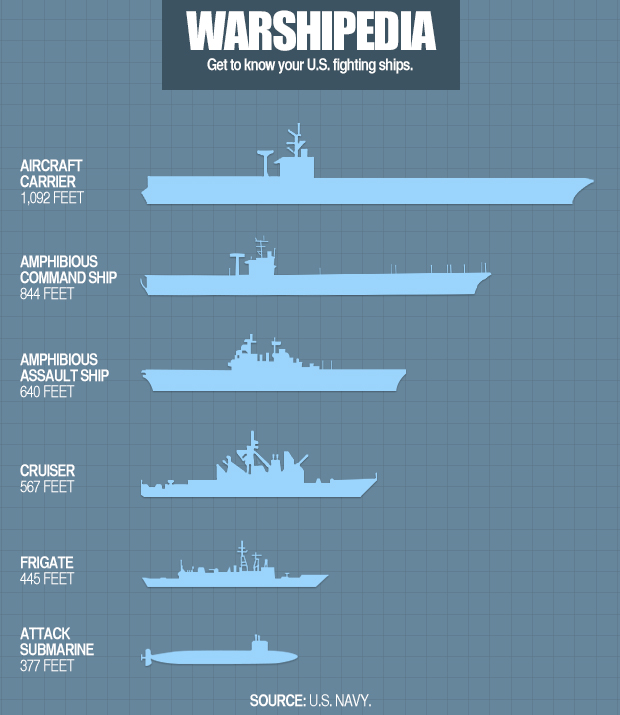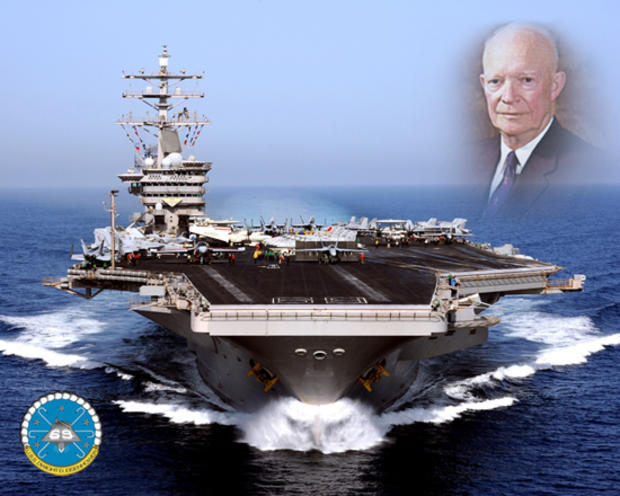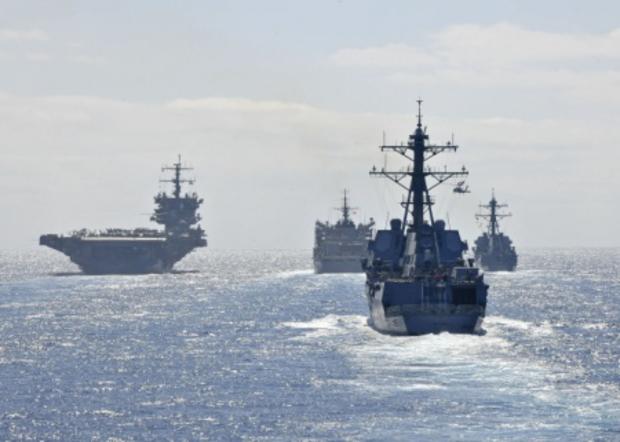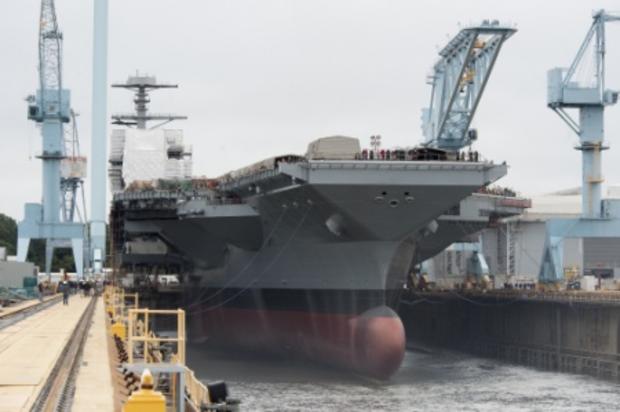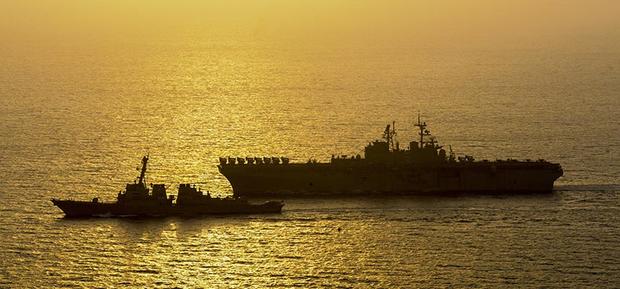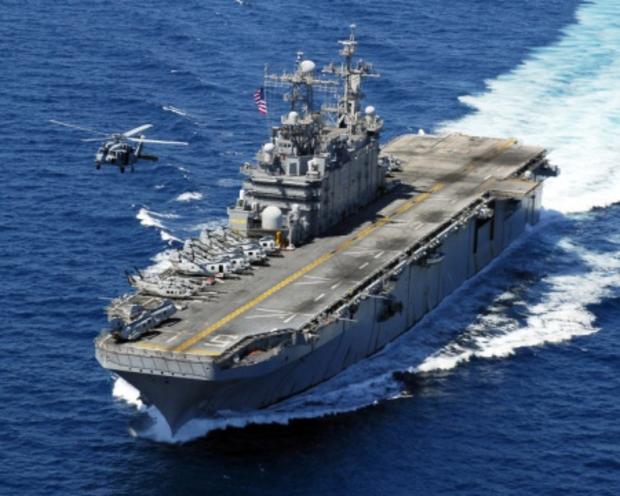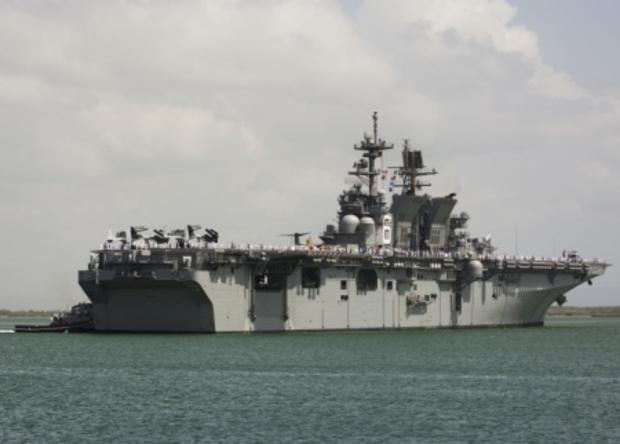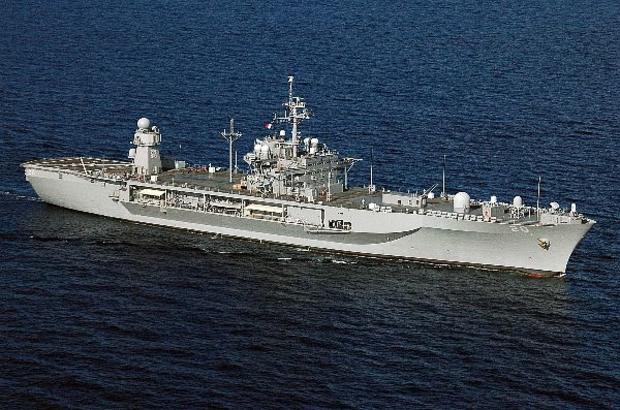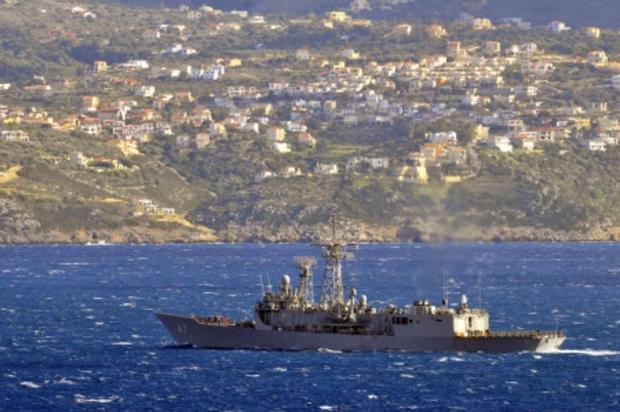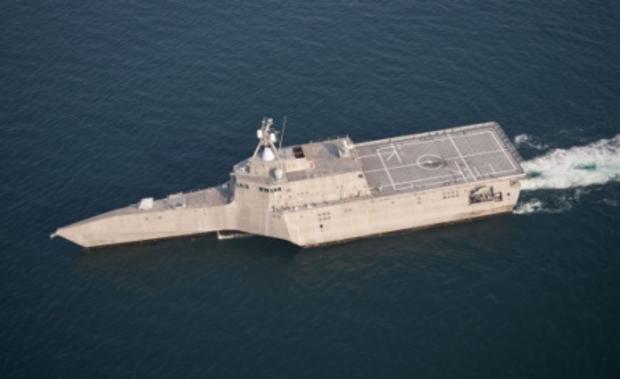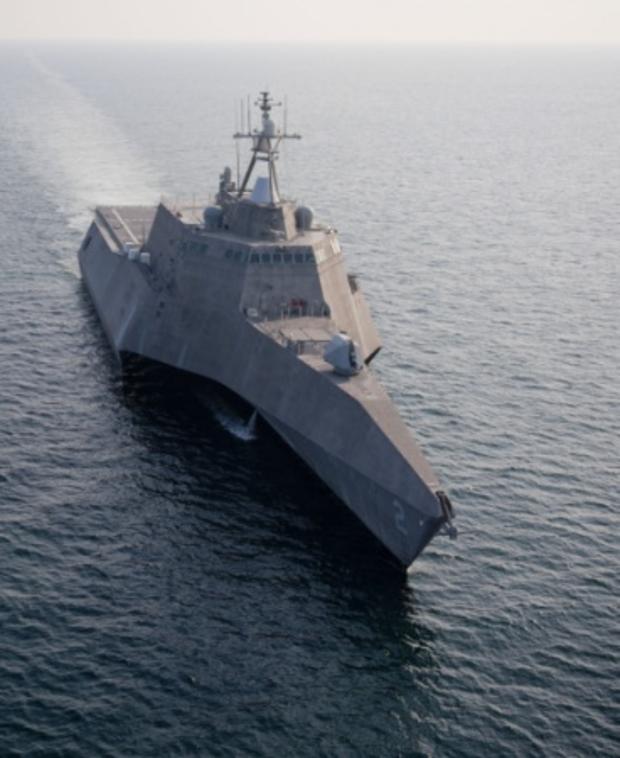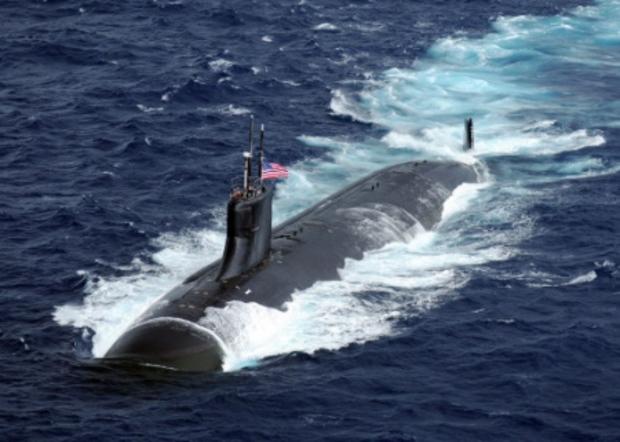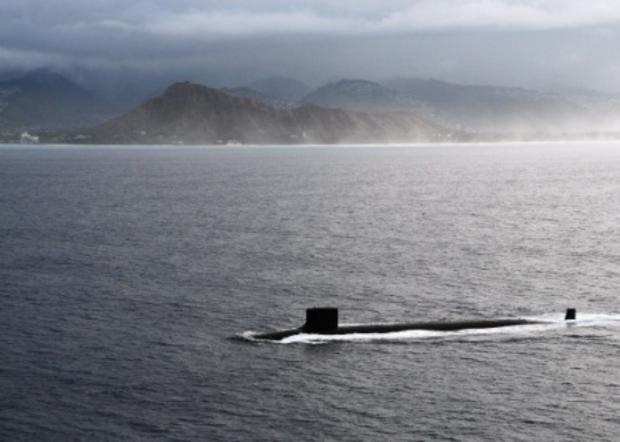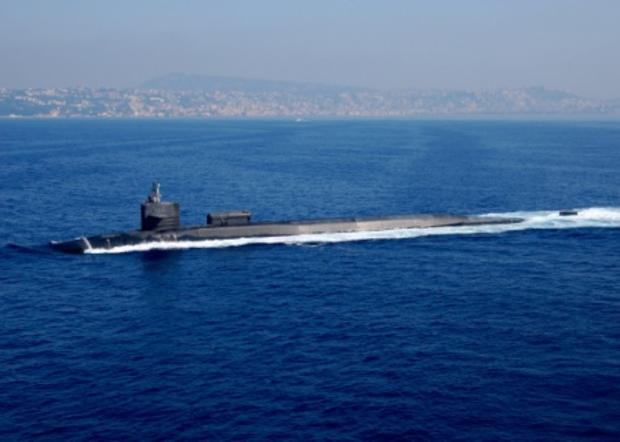Warshipedia: Get to know America's fighting ships
The U.S. Naval Fleet is as cutting edge as it is diverse. Each type of ship has a purpose. Each variant of submarine, a unique skill set. Some are big. Some are small. Yet, all of these vessels are awe-inspiring in their own right. Here's a look at the major American warships engaging in offense and defense on the high seas.
Aircraft Carriers
We begin with Aircraft Carriers because they are the centerpiece of America's Naval forces. These nuclear-powered warships serve as mobile airbases; boasting full-length flight decks with the ability to carry, arm, deploy and recover U.S. aircraft at sea.
Thus, Aircraft Carriers enable the U.S. Navy to project air power -- fighter planes, helicopters, strike aircraft, etc. -- throughout the world, without having to depend on local bases for staging. And that is huge. In fact, when these versatile warships were perfected in the mid-twentieth century, they completely transformed naval combat... a game changer in World War II.
In times of crisis, the first question leaders often ask is, "Where are the carriers?," because their presence alone has been known to deter adversaries from striking U.S. interests. As the capital ship of U.S. fleets, they keep the seas safe from terrorism and piracy, while also providing humanitarian assistance whenever needed.
Primarily named after U.S. Presidents, there are currently two active types of Aircraft Carriers in the U.S. Navy -- Nimitz and Enterprise -- with a third type coming soon.
Aircraft Carriers - Nimitz Class
Deployed in 1975, Nimitz Class Aircraft Carriers are about 1,092 feet long and each cost about $8.5 billion.
To put that in perspective, these Aircraft Carriers are larger than three football fields put together. If one were to be stood upright, its height would be just 158 feet shy of the Empire State Building.
They are extremely expensive to build, extremely crucial to naval operations and, thus, extremely important to protect.
They have two nuclear reactors, four shafts and can travel upwards of 34.5mph. The armament on these warships includes state of the art Multiple NATO Sea Sparrow, Phalanx CIWS, and Rolling Airframe Missile (RAM) mounts. And they can carry upwards of 60 aircraft. The ten Nimitz Class Carriers are the largest warships in the world, each built for 50 years of service, with one mid-life refueling.
And it's not just the dimensions and equipment capacities on these warships that are huge. Their companies are massive as well. On any given Nimitz Class Aircraft Carrier, there are between 3,000 and 3,200 military personnel in the ship's company, about 1,500 in the air wing, and around 500 others.
So, when you look at it that way, these really are floating military bases.
Aircraft Carriers - Enterprise Class
The lone ship of the Enterprise Class was deployed in 1961, and was the first nuclear-powered Aircraft Carrier. As such, it was a vastly overpowered vessel.
That's because prior to the Enterprise Class, Aircraft Carriers had eight boilers. So, when the U.S. Navy switched their propulsion over from boilers to nuclear reactors, they figured boilers and nuclear reactors were basically the same. Thus, they built the first nuclear-powered Aircraft Carrier with the same amount of nuclear reactors that there had previously been boilers: eight.
Ultimately, however, they realized that nuclear reactors are much more powerful than regular boilers. And that's why the newer classes of U.S. Aircraft Carriers only have two.
In fact, the Enterprise Class Aircraft Carrier was so overpowered that you could actually drive it fast enough to hurt its hull. In later classes, in addition to reducing the number of nuclear reactors, the Navy also strengthened Aircraft Carriers' hulls to avoid this sort of speed-induced injury.
Despite being overpowered and somewhat less than aerodynamic, though, this warship was still a force to be reckoned with. Approximately 1,101 feet in length, it boasted a company of around 3,350 personnel in the ship and 2,480 in the Air Wing.
This warship was recently retired; its 50-year lifespan taking it out of active service in 2011.
Aircraft Carriers - Ford Class
Scheduled to be delivered in 2016, the Gerald R. Ford Class is the future of U.S. Aircraft Carriers and will ultimately replace the currently active Nimitz Class.
With the same dimensions (1,092 feet long), propulsion (two nuclear reactors, four shafts) and state of the art angled decks as the Nimitz Class, these Ford Class Aircraft Carriers maintain all of the best features of the current warships, while also incorporating several key new innovations.
Each ship in the new class will save the U.S. Navy more than $4 billion in total ownership costs during its 50-year service life, compared to current Aircraft Carriers. In addition, improvements in ship design will allow the CVN 78 to operate effectively with nearly 700 fewer crew members and 400 fewer personnel in the air wing. These new ship design features and technologies are also expected to reduce watch standing, manning and maintenance, while enhancing capability.
What's more, these new aircraft carriers are the first to ever be designed with all electric utilities, eliminating steam service lines from the ship; reducing maintenance requirements and improving corrosion control, in the process. By optimizing the ship's systems and configuration, the Gerald R. Ford Class is also designed to maximize the striking power of the air wing.
Translation: bigger and better Aircraft Carriers than ever before. Well... not bigger, but definitely better.
Amphibious Assault Ships
At 844 feet in length, Amphibious Assault Ships are like miniature Aircraft Carriers. Both have similar designs and both host military aircraft that can deploy ashore, but they differ a bit in the type of military aircraft they transport.
Unlike Aircraft Carriers that generally support strike aircraft, Amphibious Assault Ships primarily host helicopters that support troops ashore. However, some of these warships are capable of embarking aircraft like Harrier Jump Jets and anti-submarine warfare helicopters with strike capabilities. Most Amphibious Assault Ships also have a well deck and, as such, the ability carry and support landing craft.
The United States maintains the largest and most capable amphibious force in the world. And there are currently three classes of these warships in use (Wasp Class, Tarawa Class, and LHA(R) Class).
Amphibious Assault Ships - Wasp Class
The Wasp Class Amphibious Assault Ships are currently the largest amphibious ships in the world.
There are eight ships active in this class: USS Wasp (LHD 1), USS Essex (LHD 2), USS Kearsarge (LHD 3), USS Boxer (LHD 4), USS Bataan (LHD 5), USS Bonhomme Richard (LHD 6), USS Iwo Jima (LHD 7), and USS Makin Island (LHD 8). The lead ship among them, the USS Wasp (LHD 1), was commissioned July 1989 in Norfolk, Virginia.
Amphibious Assault Ships in the Wasp Class are 844 feet in length. They have ship companies of 66 officers, and marine detachments of 1,687 troops. They have two boilers, two geared steam turbines, two shafts, 70,000 total brake horsepower, and can go upwards of 23.5 miles per hour.
Together with the Tarawa Class, Amphibious Assault Ships in the Wasp Class provide the Marine Corps with a means of ship-to-shore movement by both helicopter and landing craft including high speed hovercraft.
Amphibious Assault Ships - Tarawa Class
Together with the Wasp Class, Amphibious Assault Ships in the Tarawa Class provide the Marine Corps with a means of ship-to-shore movement by both helicopter and landing craft.
There is currently only one Tarawa Class warship in service, the USS Peleliu (LHA 5), based in San Diego, California.
Tarawa Class Amphibious Assault Ships have participated in major humanitarian-assistance, occupation and combat operations, including launching Marine Corps expeditionary forces into Afghanistan during Operation Enduring Freedom in 2001-2, and providing humanitarian support to Indonesia after the devastating Tsunami there in 2004.
Amphibious Assault Ships - LHA(R) Class
Delivered to the U.S. fleet in April 2014, LHA Replacement or LHA(R) Class Amphibious Assault Ships are the next step in the incremental development of the "Big Deck Amphib." They were designed to accommodate the Marine Corps' future Air Combat Element, while also providing additional cargo stowage and enabling a broader, more flexible Command and Control capability.
The USS America (LHA 6) is currently the only LHA(R) warship in service. The PCU Tripoli (LHA 7), however, is under construction and coming soon.
Like the Wasp Class, these ships are 844 feet in length. They have a crew of 1,059 personnel, 65 of which are officers, and an additional load of 1,687 troops (plus 184 surge). They have two marine gas turbines, two shafts, two RAM launchers, two NATO Sea Sparrow launchers, two 20mm Phalanx CIWS mounts, and seven twin .50 cal. machine guns.
Amphibious Command Ships
Amphibious Command Ships are large, special purpose ships, originally designed to command large amphibious invasions. However, as amphibious invasions have become more and more unlikely, they have been repurposed as general command ships, serving as the floating headquarters for various combatant commands.
There are currently only two Amphibious Command Ships in use by the U.S. Navy and they are both stationed abroad: the USS Blue Ridge (LCC 19) in Yokosuka, Japan, and the USS Mount Whitney (LCC 20) in Gaeta, Italy.
These warships are 634 feet long. They have two boilers, one geared turbine, one shaft, and 22,000 horsepower. What's more, they can carry all U.S. military helicopters, with the exception of one (the CH-53 Sea Stallion).
Cruisers
All U.S. Cruisers are named after famous battles. So, there's a USS Bunker Hill, a USS Gettysburg, a USS Normandy... you name it. If it's an important battle, it's also probably a Cruiser.
They are each 567 feet long and cost $1 billion to make.
Modern U.S. Navy guided missile cruisers perform primarily in a Battle Force role. These ships are multi-mission [Air Warfare (AW), Undersea Warfare (USW), Naval Surface Fire Support (NSFS) and Surface Warfare (SUW)] surface combatants capable of supporting carrier battle groups, amphibious forces, or of operating independently and as flagships of surface action groups. Cruisers are equipped with Tomahawk cruise missiles giving them additional long range Strike Warfare (STRW) capability. Some Aegis Cruisers have been outfitted with a Ballistic Missile Defense (BMD) capability.
Deployed in 1983, they were built with a projected 35-year service life. However, over the next several years, many Ticonderoga-class guided-missile cruisers will undergo a structured modernization to ensure that they reach this projection. The Cruiser Modernization program will revamp the computing and display infrastructure, as well as the Hull, Mechanical and Electrical (HM&E) systems. Weapons and sensor sets will also be improved, in order to upgrade their anti-submarine capabilities, add short range electro-optical systems that can monitor the ship's surroundings without the use of radar emissions, and upgrade machinery to improve all areas of ship functionality.
Destroyers
Destroyers are fast long-endurance warships that escort and defend the fleet's larger vessels against powerful short-range attackers.
They provide multi-mission offensive and defensive capabilities, and can operate both independently and as part of a group (strike, surface action, replenishment, or otherwise).
There are currently 62 Arleigh Burke class Destroyers operating in the U.S. Naval Fleet. An additional thirteen ships are under construction.
Guided Missile Destroyers are multi-mission surface combatants, participating in Anti-Air Warfare, Anti-Submarine Warfare, and Anti-Surface Warfare operations. These modern Destroyers utilize the MK-41 Vertical Launch System (VLS); and thus, are effective in strike warfare..
The upcoming Zumwalt Class of Destroyers (DDG 1000) will become the lead ships of a next-generation multi-mission surface combatants tailored for land attack and littoral dominance with capabilities that triple naval surface fires coverage and triple capability against anti-ship cruise missiles. These new Destroyers will also have vastly improved defenses against mines in shallow water regions.
Frigates
Frigates are speedy, agile warships that look like miniature cruisers. They're used to protect other warships and merchant convoys from enemy combatants, like submarines and aircraft.
However, while Guided Missile Frigates offer short range anti-air warfare capabilities, they have some limitations. They were designed as cost efficient surface combatants, so they lack the sort of multi-mission capabilities necessary for modern surface combatants faced with multiple, high-technology threats. They also offer limited capacity for growth. So, while there are currently 15 Frigates in operation, there are no further Frigates scheduled to be built in the U.S. Navy's five-year shipbuilding plan.
Despite their limitations, though, Frigates are extremely tough ships, capable of withstanding considerable damage. Take for example, when the USS Samuel B. Robertsstruck a mine and the USS Stark was hit by two Exocet cruise missiles... Both ships survived, were repaired and returned to the fleet shortly afterward.
Tough little guys, right?
Littoral Command Ships - Freedom variant
Littoral Combat Ships are fast, agile, mission-focused warships. They were designed to defeat asymmetric "anti-access" threats -- like mines, quiet diesel subs, and fast surface craft -- in the "littoral zone," a.k.a. near-shore environments. They are, however, also capable of open-ocean operation.
There are two variants of Littoral Combat Ships: Freedom and Independent. Both were initiated in February 2002. Both currently only a few ships in operation. And both have eight further ships in production.
The Freedom variant Littoral Command Ships are built by Lockheed Martin. They are 387.6 feet long and can reach upwards of 40 knots. They include: the USS Freedom, the USS Fort Worth, the PCU Sioux City (under contruction), the PCU Wichita (in pre-production), the PCU Billings (in pre-production), the PCU Milwaukee (under construction), the PCU Detroit (under construction), and the PCU Little Rock (under construction).
Littoral Command Ships - Independent Variant
Former Secretary of the Navy Gordon R. England described the concept behind Littoral Command Ships as "small, fast, maneuverable and relatively inexpensive."
They have a streamlined, modular design and can easily be reconfigured to perform a plethora of different roles, like special operations, intelligence, homeland defense and reconnaissance. Interestingly, though, most of their mission-related functions are actually performed by the vehicles they carry. Think: helicopters and unmanned vehicles that can perform sonar sweeps for mines and launch torpedoes against enemies subs at a safe distance from the ship.
Like the Freedom variant, Littoral Command Ships of the Independent variant are slightly smaller than Guided Missile Frigates and often function as small assault transports. Each LCS has a flight deck, stern ramp for operating small boats, standard armaments and a hangar that houses two Seahawk Helicopters.
So, they're not as well-equipped for air defense or surface warfare as Destroyers, but they're super fast and super flexible... with the ability to quickly and masterfully adapt to the task at hand.
Attack Sub - Los Angeles Class
With the number of foreign submarines growing by the year, the United States Submarine Force relies on its technological superiority and the speed, endurance, mobility, stealth and payload afforded by nuclear power to retain its preeminence in the undersea battlespace.
Attack submarines are designed to seek and destroy enemy submarines and surface ships; project power ashore with Tomahawk cruise missiles and Special Operation Forces (SOF); carry out Intelligence, Surveillance, and Reconnaissance (ISR) missions; support battle group operations; and engage in mine warfare.
There are three classes of these warships in the U.S. Navy: Los Angeles, Seawolf, and the upcoming Virginia. The Los Angeles Class Attack Subs are the backbone of the U.S.submarine force with 41 now in commission.
The first of these warships, the USS Los Angeles, was deployed in 1976. They are 360 feet long and are propelled with one nuclear reactor and one shaft.
Attack Submarines - Seawolf Class
The Navy also has three Seawolf-class submarines that are exceptionally quiet, fast, well-armed, and equipped with advanced sensors.
They lack Vertical Launch Systems, but they have eight torpedo tubes and can hold up to 50 at a time.
Also, while most U.S. Presidents have Aircraft Carriers named after them, the third and last ship of the Seawolf Class Attack Subs is the USS Jimmy Carter. That's because Carter actually served as a Submarine Officer for some time, under Admiral Rickover, in the U.S. Navy.
The USS Jimmy Carter has a special 100-foot hull extension, called the multi-mission platform. This accommodates advanced technology used to carry out classified research and development, as well as granting the ship enhanced warfighting capabilities.
Attack Submarines - Virginia Class
The Virginia Class, now under construction, is the next generation of Attack Submarine. These anxiously anticipated warships will have enhanced fighting capabilities, a reconfigurable torpedo room, a large lock-in/lock-out chamber for divers, and a new fly-by-wire ship control system which allows for better shallow-water handling.
In these newest models, the traditional Attack Sub periscopes will be supplanted by two photonics masts that host visible and infrared digital cameras atop telescoping arms. This switch will allow the ship's control to be moved down one deck and away from the hull's curvature, affording the commanding officer more room and enhanced situational awareness.
These ships are also specifically designed to reduce acquisition costs. As such, the traditional, air-backed sonar sphere in the bow has been replaced with a water-backed Large Aperture Bow array. This will both reduce acquisition and life-cycle costs, and improve the vessel's passive detection capabilities. Also, the 12 individual Vertical Launch System (VLS) tubes, used in current Attack Subs, will be replaced with two 87-inch Virginia Payload Tubes (VPTs), each capable of launching six Tomahawk cruise missiles. This simplifies construction, reduces acquisition costs, and provides for more payload flexibility.
Onward and upward. Or, uh... downward, as the case may be.
Fleet Ballistic Missile Submarines
Fleet Ballistic Missile Submarines are in charge of strategic deterrence. They're designed specifically for stealth and precise delivery of nuclear warheads, and they are the United States' most enduring nuclear strike ships.
Nicknamed "boomers," these subs serve as an undetectable launch platform for intercontinental missiles. In fact, each of the 14 Fleet Ballistic Missile Subs in the currently operational Ohio Class can carry up to 24 submarine-launched ballistic missiles at a time, with multiple, independently-targeted warheads.
These warships are also notable in that they're specifically designed for extended deterrent patrols. They each have two crews, which alternate manning the ship and taking it on patrol. They each have three large-diameter logistics hatches that allow sailors to rapidly transfer supply pallets, equipment replacement modules and machinery components, thereby increasing their operational availability. They each operate for 15 or more years between major overhauls. And on average, the submarines spend 77 days at sea, before docking for maintenance.
Guided Missile Submarines
The United States' four Guided Missile Submarines are converted Fleet Ballistic Missile Submarines with unprecedented strike and special operation mission capabilities. Just as stealthy a platform as they were in their former life, these subs are now armed with tactical missiles and equipped with superior communications capabilities. As such, they're capable of directly supporting Special Operation Forces and Combatant Commander strikes.
Basically, in 1994, a review determined that the U.S. only needed 14 of its 18 Fleet Ballistic Missile Subs to meet its strategic force needs. So, the Navy decided to transform four of those Ohio-class Subs into conventional land attack and SOF platforms. This allowed the Navy to leverage existing submarine technology -- a more more cost effective option than designing an entirely new platform -- while simultaneously expanding capability to meet the current and future needs of U.S. combatant commanders.
It's like the U.S. Navy and the extraneous Fleet Ballistic Missile Subs looked at each other and said, "I'll scratch your back, if you scratch mine." Sweet deal.
